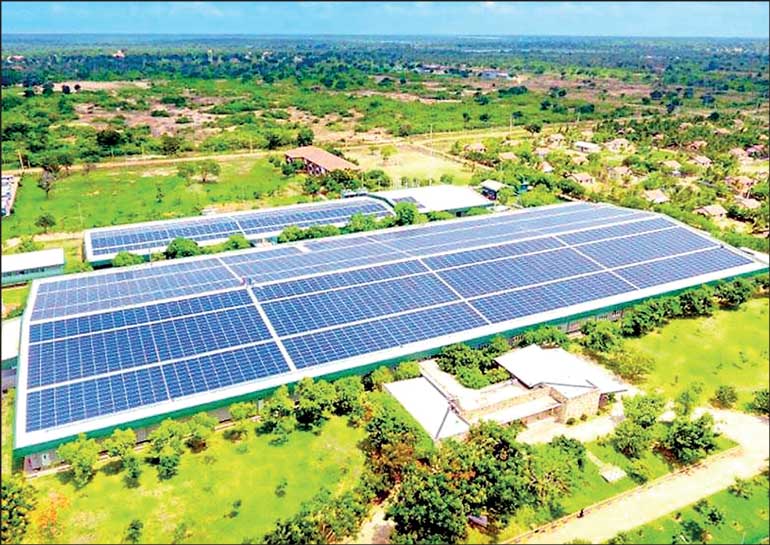Tuesday Dec 09, 2025
Tuesday Dec 09, 2025
Saturday, 7 December 2024 00:10 - - {{hitsCtrl.values.hits}}

Sri Lanka can significantly advance its climate change ambition and negotiate from a point of strength for increased flow of concessional climate finance to realise its ambitious strategy for energy transition to achieve energy sovereignty
Now it is technically possible to operate power grids comprising of close to 100% renewable energy sources such as hydro power including pump storage hydro, solar and wind and battery energy storage. The Sri Lanka Electricity Act of 2024 provides the legal framework for this. For a country like Sri Lanka, which is entirely dependent on imported fossil fuel such as oil, coal and LNG (in the future), this provides an opportunity to achieve complete energy sovereignty by eliminating the need for fossil fuel imports. This would provide reliable, indigenous electricity which is not exposed to fluctuations in global fuel prices and exchange rate
 There has been general consensus among scientists and world leaders apart from incoming US president that global warming caused by increased level of greenhouse gases (GHG) in the atmosphere since the industrial revolution is causing lasting damage to the global environment. There has been an increasing number of adverse weather events such as cyclones, floods and droughts in different parts of the world, rise in the sea water levels due to glacial melting resulting in coastal flooding and salinity intrusion affecting the drinking water supply and desertification of hitherto fertile lands. Most of these adverse impacts are felt in the poorer countries in Africa and Asia. Sri Lanka is also not immune to these impacts as evident from the increasing salinity level in Kelani River.
There has been general consensus among scientists and world leaders apart from incoming US president that global warming caused by increased level of greenhouse gases (GHG) in the atmosphere since the industrial revolution is causing lasting damage to the global environment. There has been an increasing number of adverse weather events such as cyclones, floods and droughts in different parts of the world, rise in the sea water levels due to glacial melting resulting in coastal flooding and salinity intrusion affecting the drinking water supply and desertification of hitherto fertile lands. Most of these adverse impacts are felt in the poorer countries in Africa and Asia. Sri Lanka is also not immune to these impacts as evident from the increasing salinity level in Kelani River.
The main causes for increasing GHG emissions is fossil fuel use in electricity generation and transportation as well as certain industries such as steel, cement and chemical processing. In addition, the changes in land use and deforestation are also contributing to increased levels of GHG as forests absorb carbon dioxide (i.e. main contributing GHG to global warming).
A. Global efforts to address climate change (1997-2015)
As preserving the climate is a global public good and no individual country or actor has the sole responsibility for doing so, the United Nations has stepped into coordinating global efforts in this regard. The United Nations Framework Convention on Climate Change (UNFCC) was signed in 1992 and 194 countries including Sri Lanka has joined the UNFCC. The Conference of Parties (COP) to UNFCC meets on annual basis to review the progress made and agree on future actions. The 29th annual meeting of COP was recently concluded in Baku Azerbaijan. There have been several global agreements under the UNFCC that have been signed in the past. Although the results in terms of arresting the increase in GHG levels is less than expected, there has been some progress in slowing down the increasing levels of GHG emissions since 1990.
The first major accord was the Kyoto Protocol signed in 1997 and came into effect in 2005. It required developed countries to reduce GHG emissions by 5% compared to 1990 levels and established a system to monitor countries’ progress. But it did not compel major developing countries like China and India to reduce GHG emissions and USA refused to ratify the protocol due to that. The Kyoto protocol also established the Clean Development Mechanism (CDM) to allow developed countries to purchase certified emission reductions (CER) realised in developing countries through specific investment projects in renewable energy, fuel switching, energy efficiency and industrial processes.
These purchased CERs can be considered in fulfilling the emission reductions commitments of developed countries during 2008-2012. The developed countries imposed several conditions for eligibility of projects and CERs beyond 2012 and some of them withdrawn from the protocol. As a result, it has been effectively dormant since 2012. There have been several mini hydro projects in Sri Lanka implemented prior to 2012, that has managed to be registered for CDM and sell the CER to buyers from developed countries.
B. Paris Agreement
Due to the failure of the Kyoto protocol to establish a functioning carbon market and set a global price on carbon emissions, the Paris Agreement was signed in the COP 21 meeting in 2015 to strengthen the international efforts to address climate change. This is a legally binding international treaty, and it has been ratified by 196 countries including Sri Lanka. Its main objective is to keep global warming below 2 degrees. The countries are required to submit Nationally Determined Commitments (NDC)s climate change mitigation and adaptation outcomes to be achieved by 2030. The NDCs are required to be updated every five years and the updated NDCs are required to be submitted in 2025. A transparent mechanism for monitoring the progress made by each country is established under the UNFCC.
The COP has also agreed to establish a climate finance mechanism to ensure a net resource flow of at least $ 100 billion per annum by 2020 from developed countries to finance mitigation and adaptation activities in developing countries. This target is supposed to have been met by 2022. The recent COP 29 has agreed to increase this to $ 300 billion per annum by 2035. This can be done in the form of grants, concessional and concessional loan, official bilateral assistance and private sector investments. In addition, the Paris Agreement requires the countries to make non-legally binding long-term commitments to achieve the objectives of the Paris Agreement. A number of countries including Sri Lanka have set aspirational goals to achieve net zero emissions by 2050 and beyond.
C. Technological changes
In parallel with the developments in global institutional architecture under UNFCC, there have been major technological advancements that have made achieving net zero emissions a possibility. These include rapid and sustained cost reduction in solar and wind power and battery energy storage, electrical vehicles and green hydrogen. This has made wind and solar energy combined with energy storage, the cheapest source of firm energy in number of countries including Sri Lanka compared to new power plants based on fossil fuel such as coal and LNG.
There have been advancements in electrical power systems to address the other technical challenges to integrating large scale intermittent renewable capacity consisting of non-synchronous generators. Electric vehicles are now cost competitive vis a vis internal combustion engine vehicle and when combined with railway electrification can significantly reduce the use of petroleum in the transport sector. The green hydrogen produced from renewable energy can be used in fertiliser industry to produce green ammonia to save the foreign exchange outflows on imported urea produced using natural gas.
Now it is technically possible to operate power grids comprising of close to 100% renewable energy sources such as hydro power including pump storage hydro, solar and wind and battery energy storage. The Sri Lanka Electricity Act of 2024 provides the legal framework for this. For a country like Sri Lanka, which is entirely dependent on imported fossil fuel such as oil, coal and LNG (in the future), this provides an opportunity to achieve complete energy sovereignty by eliminating the need for fossil fuel imports. This would provide reliable, indigenous electricity which is not exposed to fluctuations in global fuel prices and exchange rate.
D. Sri Lanka’s NDCs
The rationale for energy transition to minimise the carbon footprint in Sri Lanka can be justified purely on national considerations without considering the global co-benefit of climate change mitigation. Sri Lanka does not have any developed indigenous fossil fuel industry unlike countries like China and India which have millions of people depending on coal industry. The socio economic cost of energy transition is likely to be relatively less while the benefits in terms of energy sovereignty, reduction in foreign exchange outflow of nearly $ 5 billion a year and reduction in local air pollution and resultant health impacts are immense.
In the NDCs submitted in 2020, the key outcomes to be achieved by 2030;
The updated NDCs to be submitted by Sri Lanka by 2025, provides an opportunity for Sri Lanka to outline a more ambitious set of targets for energy transition as a clear pathway to achieve net zero target to be achieved by 2050. The new NDCs can attempt to completely phase out the fossil oil including natural gas usage in electricity generation. Sri Lanka can present two sets of outcome targets with more ambitious targets contingent upon availability of defined level of concessional climate finance. In the updated NDCs to be submitted by 2025 which need to set quantifiable outcomes to be achieved by 2035, Sri Lanka can consider following;
Sri Lanka can significantly advance its climate change ambition and negotiate from a point of strength for increased flow of concessional climate finance to realise its ambitious strategy for energy transition to achieve energy sovereignty. This will catalyse and leverage additional private investments in renewable energy and energy transition if transparent and competitive mechanisms as required under the Sri Lanka Electricity Act of 2024 are put in place for selection and solicitation of new investments in renewable energy.
The new Government needs to undertake a comprehensive assessment in collaboration with private sector stakeholders about the feasibility before finalising the NDCs to be submitted to UNFCC. The international assistance required for more ambitious targets should be clearly laid out in the NDCs.
(The writer has been a senior official in the Asian Development Bank for over 20 years and recently he held the position of Director General Power Sector Reform Secretariat in Sri Lanka. He graduated from University of Moratuwa and possesses a PhD degree from Imperial College UK. He can be reached at [email protected].)